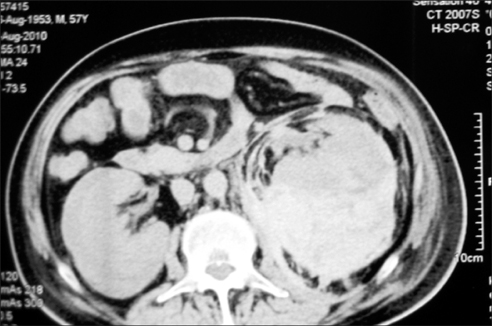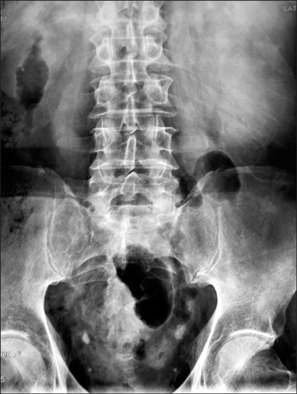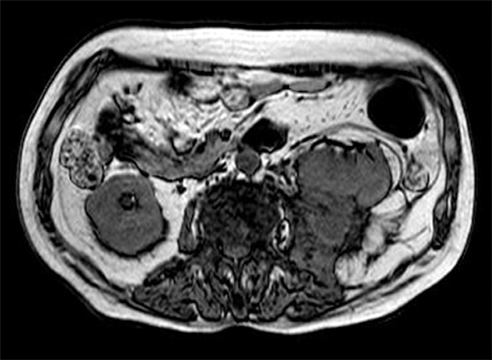Korean J Urol.
2012 Jul;53(7):502-504. 10.4111/kju.2012.53.7.502.
Bilateral Ureteral Stones and Spontaneous Perirenal Hematoma in a Patient with Chronic Idiopathic Thrombocytopenic Purpura
- Affiliations
-
- 1Clinic of Urology, Haydarpasa Numune Training and Research Hospital, Istanbul, Turkey. hmakyuz@yahoo.com
- KMID: 1988764
- DOI: http://doi.org/10.4111/kju.2012.53.7.502
Abstract
- Idiopathic thrombocytopenic purpura (ITP) is an immune thrombocytopenia with a usually benign clinical course. Bleedings are mostly of the mucocutaneous type with mild symptoms. Massive bleedings requiring transfusion are rarely seen, unless the number of platelets decreases to extremely low levels. In this case, bilateral perirenal hematoma and bilateral distal ureteral stones were detected on a non-contrast computed tomography scan of a 57-year-old male patient who developed macroscopic hematuria during his treatment in the clinics of internal medicine because of left flank pain and diffuse petechial rashes all over his body. The patient, who had been receiving chronic ITP treatment for 1 year, had a very low platelet count (4,000/mm3). The patient was prescribed bed rest, and his platelet count increased to a safe level for surgical intervention of above 50,000/mm3 with administration of prednisolone, intravenous immune globulin, and platelet suspension. A stone-free state was achieved after bilateral ureterorenoscopy and pneumatic lithotripsy. A conservative approach was followed for the perirenal hematoma. Upon regression of the perirenal hematoma, the patient was discharged at 9 weeks postoperatively.
Keyword
MeSH Terms
Figure
Reference
-
1. Cohen YC, Djulbegovic B, Shamai-Lubovitz O, Mozes B. The bleeding risk and natural history of idiopathic thrombocytopenic purpura in patients with persistent low platelet counts. Arch Intern Med. 2000. 160:1630–1638.2. Godeau B, Provan D, Bussel J. Immune thrombocytopenic purpura in adults. Curr Opin Hematol. 2007. 14:535–556.3. Cines DB, Bussel JB, Liebman HA, Luning Prak ET. The ITP syndrome: pathogenic and clinical diversity. Blood. 2009. 113:6511–6521.4. Liu CC, Huang CH, Su YC, Shih MC, Chou YH. Spontaneous renal hemorrhage associated with idiopathic thrombocytopenic purpura: a case report. Kaohsiung J Med Sci. 2002. 18:149–152.5. Ikeda I, Terao T, Nakagomi K, Masuda M, Hirokawa M. Idiopathic thrombocytopenic purpura (ITP) associated with renal injury: report of a case. Hinyokika Kiyo. 1993. 39:151–153.6. Lateef A, Kueh YK. Severe intra-abdominal haemorrhage: a consequence of two coinciding events. Singapore Med J. 2007. 48:e237–e239.7. Seckin H, Kazanci A, Yigitkanli K, Simsek S, Kars HZ. Chronic subdural hematoma in patients with idiopathic thrombocytopenic purpura: a case report and review of the literature. Surg Neurol. 2006. 66:411–414.8. Seseke S, Schreiber M, Rebmann U, Seseke F. Spontaneous perirenal hematomas in patients taking anticoagulation medication or having a bleeding diathesis. Aktuelle Urol. 2008. 39:215–218.9. Ruiz Marcellan FJ, Mauri Cunill A, Cabre Fabre P, Argentino Gancedo Rodriguez V, Guell Oliva JA, Ibarz Servio L, et al. Extracorporeal shockwave lithotripsy in patients with coagulation disorders. Arch Esp Urol. 1992. 45:135–137.10. Tsuboi T, Fujita T, Maru N, Matsumoto K, Iwamura M, Baba S. Transurethral ureterolithotripsy and extracorporeal shock wave lithotripsy in patients with idiopathic thrombocytopenic purpura. Hinyokika Kiyo. 2008. 54:17–22.





